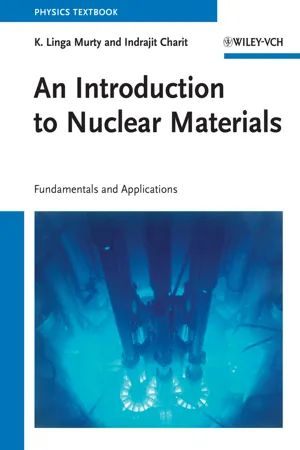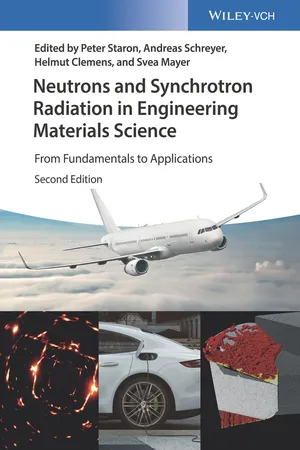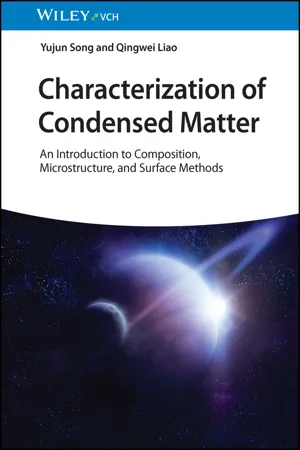Technology & Engineering
Unit Cells
Unit cells are the basic building blocks of crystalline materials, representing the smallest repeating unit of the crystal lattice. They are used to describe the arrangement of atoms or ions in a crystal structure and are characterized by their specific geometric shape and dimensions. Understanding unit cells is crucial in materials science and engineering for designing and manipulating the properties of materials.
Written by Perlego with AI-assistance
Related key terms
Related key terms
1 of 4
Related key terms
1 of 3
4 Key excerpts on "Unit Cells"
- eBook - ePub
An Introduction to Nuclear Materials
Fundamentals and Applications
- K. Linga Murty, Indrajit Charit(Authors)
- 2013(Publication Date)
- Wiley-VCH(Publisher)
Figure 2.2 .Figure 2.2 Materials science and engineering tetrahedron.This theme is equally applicable to the nuclear materials. For example, materials scientists and engineers study microstructural features (grain size, type of second phases and their relative proportions, grain boundary character distribution to name a few) to elucidate the behavior of a material. These are structural features that are influenced by the nature of the processing techniques (casting, rolling, forging, powder metallurgy, and so forth) employed, leading to changes in properties. This understanding will be very helpful as we wade through the subsequent chapters.A lattice is an array of points in three dimensions such that each point has identical surroundings. When such lattice point is assigned one or more atoms/ions (i.e., basis), a crystal is formed. In this chapter, we present a simple treatment of the crystal structure and relate it to its importance with respect to nuclear materials. There are 7 basic crystal systems and a total of 14 unique crystal structures (Bravais lattices) that can be found in most elemental solids. These are based on the crystal symmetry and the arrangement of atoms as described in the following sections.2.1.1 Unit Cell
A unit cell is the smallest building block of a crystal, which when repeated in translation (i.e., with no rotation) in three-dimension can create a single crystal. Therefore, a single crystal or a “grain” in a polycrystalline material would contain many of these Unit Cells. A general unit cell can be created based on three lattice translation vectors (a , b , and c ) on three orthogonal axes and interaxial angles (α , β , and γ ), which are also known as lattice parameters or lattice constants. Figure 2.3 illustrates the definitions of the lattice parameters and the angles. There are seven basic crystal systems. They are summarized in Table 2.1 - eBook - ePub
Neutrons and Synchrotron Radiation in Engineering Materials Science
From Fundamentals to Applications
- Peter Staron, Andreas Schreyer, Helmut Clemens, Svea Mayer, Peter Staron, Andreas Schreyer, Helmut Clemens, Svea Mayer(Authors)
- 2017(Publication Date)
- Wiley-VCH(Publisher)
The structure of engineering materials relates to the arrangement of its internal components. On an atomic level, a structure is understood as the organization of atoms relative to each other. In crystalline materials, the atoms are arranged in periodically repeating arrays which are termed crystal or lattice structures. Metals, for instance, have particularly simple crystal structures: (i) face-centered cubic (fcc), (ii) body-centered cubic (bcc), (iii) hexagonal closed-packed (hcp), and (iv) tetragonal. Many metals and their alloys exist in more than one crystal structure depending on the temperature and composition, but, in most cases, transitions are between these four crystal structures. In contrast, semiconductors usually crystallize either in the diamond structure (silicon, germanium) or often in the zincblende structure (e.g., gallium arsenide).The next larger structural level is the microscopic level. Here, large groups of atomic arrangements are considered as components of the microstructure, which determines most of the properties of the material. The microstructure of engineering materials is described by the grain size, types of phases present, and description of their structure, shape, and size distributions. In addition, two-dimensional defects such as grain boundaries and heterophase interfaces, one-dimensional defects such as dislocations, and zero-dimensional defects such as point defects are important microstructural features that often control the resulting properties.In this introductory chapter, the microstructure of engineering materials is explained with focus on structural metallic materials, showing a polycrystalline multiphase assembly. The most important microstructure parameters are presented and their influence on mechanical properties is briefly discussed. Table 1.1 - eBook - ePub
- Anthony R. West(Author)
- 2014(Publication Date)
- Wiley(Publisher)
1 Crystal Structures and Crystal ChemistrySolid state chemistry is concerned mainly with crystalline inorganic materials, their synthesis, structures, properties and applications. A good place to begin is with crystal structures and crystal chemistry . All necessary crystal structure information is contained in data on Unit Cells, their dimensions and the positions or atomic coordinates of atoms inside the unit cell. Crystal chemistry combines this basic structural information with information about the elements, their principal oxidation states, ionic radii, coordination requirements and preferences for ionic/covalent/metallic bonding. A working knowledge of the Periodic Table and the properties of elements is, of course, invaluable to be able appreciate crystal chemistry, but conversely, knowledge of crystal structures and especially crystal chemistry provides a very useful way to gain increased understanding of the elements and their compounds.Many of the properties and applications of crystalline inorganic materials revolve around a surprisingly small number of structure types. In this chapter, the main families of inorganic structures are reviewed, especially those which have interesting properties; more details of the vast array of structures may be found in the encyclopaedic text by Wells and also in the Wyckoff Crystal Structures book series. First, however, we must consider some basic concepts of crystallography.1.1 Unit Cells and Crystal SystemsCrystals are built up of regular arrangements of atoms in three dimensions; these arrangements can be represented by a repeat unit or motif called the unit cell . The unit cell is defined as the smallest repeating unit which shows the full symmetry of the crystal structure . Let us see exactly what this means, first in two dimensions. A section through the NaCl structure is shown in Fig. 1.1(a) ; possible repeat units are given in (b) to (e). In each, the repeat unit is a square and adjacent squares share edges and corners. Adjacent squares are identical, as they must be by definition; thus, all the squares in (b) have Cl− - eBook - ePub
Characterization of Condensed Matter
An Introduction to Composition, Microstructure, and Surface Methods
- Yujun Song, Qingwei Liao(Authors)
- 2023(Publication Date)
- Wiley-VCH(Publisher)
In mineralogy and crystallography, crystal structure describes a unique arrangement of atoms or molecules in a crystalline liquid or solid. A crystal structure is composed of a pattern, a set of atoms arranged in a particular way, and a lattice exhibiting long‐range order and a characteristic symmetry. Patterns are located upon the points of a lattice, which is an array of points repeating periodically in three dimensions. The points can be thought of as forming identical tiny boxes, called Unit Cells, that fill the space of the lattice. The lengths of the edges of a unit cell and the angles between them are called the lattice parameters. A crystalline structure is similar to a kind of three‐dimensional wallpaper, an infinite repetition of some entity (such as a series of atoms or molecules). The procedure for creating a pattern consists of performing the point group operations that define it, such as rotation, reflection, and inversion. Making the wallpaper requires a movement (with or without rotation and reflection) to create a lattice that is a complete structure. In practice, crystalline structures can consist of single lattices or multiple grids to synthesize complex crystalline molecules. As long as it is repeatable, X‐ray diffraction can be used to determine its structure.3.2.3 Unit Cell and Unit Vectors
The unit cell (the smallest repeating entity) is the basic structural unit of a crystal structure. Its geometry and atomic positions define the crystal structure, representing the symmetry of the crystal structure (Figure 3.6 ). More than one unit cell can usually be chosen for a given crystal, but by convention/convenience, the one with the highest symmetry is selected. Some metals, as well as nonmetals, may assume more than one crystal structure, a phenomenon known as polymorphism. In elemental solids, the condition is often termed allotropy. The prevailing crystal structure depends on conditions – mainly temperature and pressure. Since the unit cell of any crystal can be regarded as a parallelepiped, what is the difference between different crystals? There are mainly two differences: (i) different crystal Unit Cells may have different sizes and shapes; (ii) the type, number, and distribution of atoms surrounding around each lattice point may be different.Lattice and crystal structures of γ‐Fe and Cu3 Au.Figure 3.6The size of the unit cell obviously depends on the length of the three crystal axes a, b, and c, while the shape of a unit cell depends on the angles α, β, γ between them (Figure 3.7 ). The parameters a, b, c, α, β and γ are called the lattice parameters of a crystal structure. In general, a ≠ b ≠ c and α ≠ β ≠ γ. The six lattice parameters (or three lattice vectors a, b, and c) describe the shape and size of the unit cell and determine the entire lattice that are formed by the translation of these vectors. That is to say, any lattice point in the spatial lattice can be generated by repeated translation along the vectors a, b, and c
Index pages curate the most relevant extracts from our library of academic textbooks. They’ve been created using an in-house natural language model (NLM), each adding context and meaning to key research topics.
Explore more topic indexes
Explore more topic indexes
1 of 6
Explore more topic indexes
1 of 4



